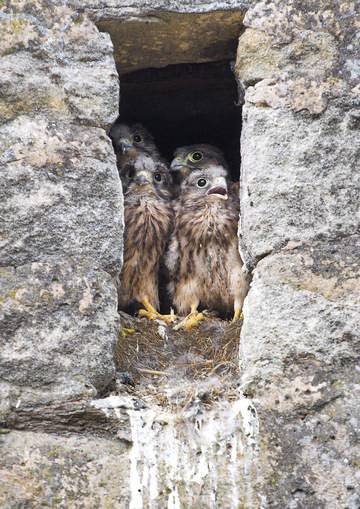
Kestrels © Simon Booth
Breeding Kestrels are found at any altitude and almost every habitat. The habitat codes recorded were mostly farmland (63% of records), especially grassland areas, with 15% woodland, 12% human sites, 4% scrub and 3% semi-natural grassland and marsh. They occupy much the same number of tetrads as twenty years ago, but the ‘change’ map shows that their distribution has altered significantly. In our First Atlas, Kestrels were present in almost every tetrad in Wirral, Halton and Warrington, and around Northwich and Chester; whereas now there are substantial gaps in their presence in those areas. On the other hand, the species has spread into much of central, southern and south-western Cheshire where it used to be missing. The net effect is a shift in habitat, with a reduction in urban Kestrels and an increase in rural birds.
This loss from many urban areas has not previously been noted in the county and merits more research as it is not readily explicable. The spread in rural Cheshire is perhaps linked to changed agricultural practices, including the widespread adoption of Environmental Stewardship with uncropped field margins and sympathetically managed hedges. These measures have been vital in Barn Owl conservation, but are benefiting Kestrel which is the diurnal equivalent, filling the same ecological niche.
Their most successful and best-known hunting technique is hovering, facing into the wind and keeping stationary by tilting the tail, scanning the ground below for some movement. But hovering is energy-demanding and kestrels often switch to three other methods of hunting: perching, dropping onto prey below; walking on the ground, sometimes looking into mammal-runs in grass, or taking invertebrates; and a low flight, like a Sparrowhawk, used to catch small birds. Their diet is a mixture of mammals, birds and invertebrates. Some Kestrels take mainly Field Voles, and their breeding population varies cyclically according to the abundance of their prey. During this Atlas, 2004 and 2005 were average years, with 2006 a year of very low Field Vole numbers, and in well-studied areas of Cheshire only about one-third of the normal number of Kestrels nested. Urban Kestrels take more mice, rats and birds, up to the size of pigeons, usually fledglings. Females are larger than males, and there is some difference in their diet. Males take more insects, especially beetles, and females take more earthworms. Males are more proficient at catching birds, with young Starlings especially a favoured target.
Their wide range of nesting sites gives them an unfettered choice of tetrad: large holes in trees, old corvid nests, ledges on any type of human artefact and nest-boxes are all readily taken. They usually start laying around the end of April, but can be a month earlier in years of plenty, or delay by a month (or not breed at all) if food is scarce. They take no particular steps to conceal their nests, and observers found nests in 77 tetrads, with adults carrying prey for their young in a further 55 and recently-fledged chicks, often with tufts of down visible, confirming breeding in another 51 tetrads.
The BTO BBS analysis shows that the breeding population of Cheshire and Wirral in 2004-05 was 1,300 birds (650-1,960). Kestrels can breed at one year of age, but only 20-40% of females do so, and half that proportion of males, never successfully (Shrubb 1993), so some of those counted on BBS transects will have been non-breeding immature birds. Assuming that 400 were non-breeders and that, in most cases, only the male of each pair was seen – the female being occupied with incubation – the Cheshire and Wirral total of Kestrels is likely to have been in the range 600-800 pairs. This is double the estimate of 350 pairs in the First Atlas, partly because that figure now appears to be too low, and partly because the local population has risen. The BBS figure amounts to 2.6% of the UK population, suggesting that Cheshire and Wirral provide particularly good habitats for Kestrels.
Sponsored by S. C. Nichols

